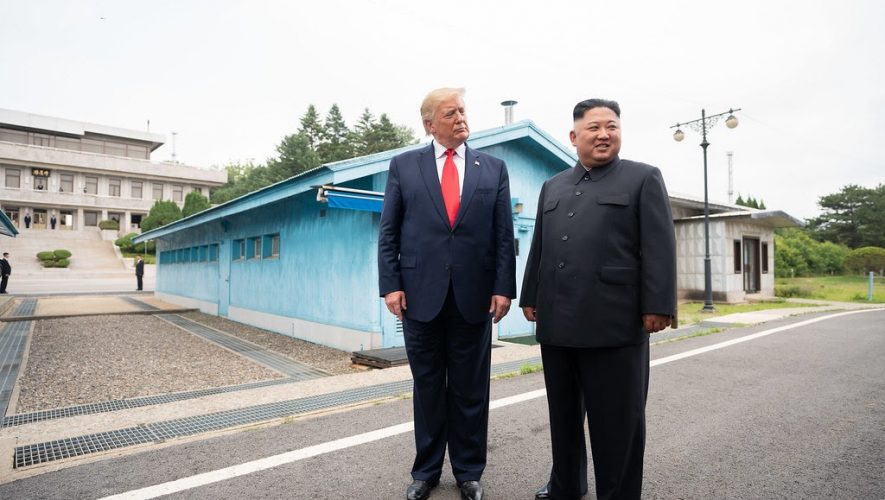Motivational speaker Simon Sinek once said, “Dream big. Start small. But most of all, start.” Washington’s North Korea policy doesn’t follow this adage, instead negotiating for total denuclearization instead of small victories.
Complete, Verifiable, Irreversible Denuclearization can be the goal. The idea isn’t new; however, as President Clinton’s chief negotiator with North Korea Robert Gallucci says, “there’s no way of doing something that’s irreversible.” This is part of the reason why past administrations have failed.
Without policy reform, Pyongyang can continue to build its arsenal unchecked. The US should strive for the cessation of nuclear and missile-related activities and remain strategically consistent regardless of who has power.
At the 2019 Hanoi Summit, President Trump held out for the “big deal”—sanctions relief for denuclearization—and received bipartisan plaudits for not rushing to a “bad deal.” However, he threw away a golden opportunity to freeze North Korea’s progress. Achieving total denuclearization is an unlikely, distant dream. The cessation of missile and nuclear development, while allowing North Korea to retain existing weapons, is a prerequisite for a nuclear-free Korean peninsula, so striving for that end is more realistic.
Conflicting Motivations
The US toppled Iraq’s Saddam Hussein and Libya’s Muammar Gaddafi in part because it did not fear nuclear retaliation. As such, Kim Jong-un finds it risky to trade away his arsenal; the weapons mitigate the threat of a US attack and keep Pyongyang independent.
Since its inception, North Korea has valued juche or self-determination. Nuclear weapons ensure juche and have come to define the Kim regime. Denuclearizing would cost Kim Jong-un this legacy and increase the risk of regime change. Without nuclear capabilities, North Korea could be overpowered by a South-led unification effort, spelling the dictatorship’s end.
Inconsistent US policy exacerbates the fundamental, mutual distrust on both sides. A denuclearization effort will span several administrations, so Washington must be consistent to ensure Pyongyang that it’s committed to key objectives such as ending the Korean War, normalizing relations, and withdrawing US forces and strategic weapons from the Korean peninsula.
“The past four administrations have significantly miscalculated the effectiveness of economic incentives. North Korea will not completely denuclearize just for sanctions relief.”
Denuclearization policy has constantly shifted from dovish diplomacy to hawkish threats even within administrations. Trump’s withdrawal from the Obama administration’s US–Iran nuclear agreement illustrates that even when a president makes one step forward towards diplomacy, a new one can push the country back two.
America’s ultimate goal is to eliminate North Korea’s nuclear capabilities. President Clinton shifted between threats and diplomacy to push Pyongyang to sign the Nuclear Nonproliferation Treaty, which required non-nuclear states to renounce development and acquisition of such weapons. The eventual 1994 Agreed Framework—in which Pyongyang promised to freeze operations at key facilities at Yongbyon in exchange for no US nuclear attacks—failed partially because the Republican-controlled Congress opposed the agreement. Congress imposed sanctions and stalled on the agreed-upon energy assistance, which Pyongyang took as Washington’s unwillingness to follow through with the deal.
The next president, George Bush, effectively killed diplomatic hope by including North Korea in the “Axis of Evil.” He later reversed course and participated in talks with China, Japan, both Koreas, and Russia to end North Korea’s nuclear program; these negotiations culminated in a two-phase agreement to freeze and disable facilities at Yongbyon. However, Pyongyang—unconvinced that the other states would honor their commitments—conducted its first nuclear test in 2006.
Obama took office in 2009, a year that saw North Korea conduct its second nuclear test and detain two US journalists. The president initially pushed to renew diplomatic engagement, but also imposed sanctions and conducted joint military exercises with South Korea—something North Korea still criticizes.
In 2012, the two parties crafted the Leap Day Deal, but the US walked away over a disagreement on the moratorium of certain types of missiles. After Pyongyang increased its nuclear testing, Obama adopted “strategic patience;” he tightened sanctions and effectively cut diplomatic ties, indicating mixed intentions to resolve the issue.
Trump had similar demands as previous administrations but escalated the conflict. His attitude constantly shifted—he swung from praising Kim to making threats that military options were “locked and loaded.” At the end of 2017, experts saw a fifty-fifty chance of war, with Senator Lindsey Graham even stating that there was a thirty percent chance of the US launching an unprovoked military strike.
Once tensions were defused—mostly by South Korean intervention—Trump and Kim held two summits and signed superficial agreements that contributed little. Once again, the US sent mixed messages and failed to seize deals that could have led to small, yet significant progress.
The past four administrations have significantly miscalculated the effectiveness of economic incentives. North Korea will not completely denuclearize just for sanctions relief, as the regime doesn’t want this reprieve as much as the US wants denuclearization. Kim has no problem developing nuclear weapons unchecked and taking on mutually assured destruction if the US attacks first. In his 2020 new year speech, he mentioned that North Korea will achieve prosperity even if it means “tightening our belts.”
This indicates that Pyongyang is ready for a long confrontation that may require sacrificing economic prosperity for security. The US has much more to lose from a nuclear war, as Kim would be willing to accept collateral damage if it meant taking down the US.
It is infeasible to completely denuclearize North Korea under these circumstances.
The US exacerbates the expansion of Pyongyang’s capabilities by preserving hardline policies and flirting with the use of force. Lowering demands to permanent cessation of the missile and nuclear weapons program would go a long way to break this stalemate.
Narrowing Window for Diplomacy
In June, North Korea resumed a hostile attitude toward South Korea by shutting down communication channels and blowing up the Inter-Korean Joint Liaison Office. With speculation that Kim may soon unveil a “new strategic weapon” that can reach the US mainland, negotiations would have to commence promptly.
For now, the goal should be capping Pyongyang’s arsenal before it becomes potent enough to accurately target the US mainland. It is difficult to preemptively strike missiles, since newer solid-fuel missiles take only a few minutes to launch compared to liquid-fuel ones that take hours. Further, road-mobile launchers can hide in the rugged mountainside, making it harder to target. If Pyongyang were able to hit any US target freely, negotiations would be stymied further.
“It’s time presidents think smaller and strive for something they can actually achieve. The constant undoing of quick deals has to be replaced by action-to-action exchanges consistent across several administrations.”
Considering how long the US has been unsuccessful, it should concentrate on freezing North Korea’s nuclear and missile program. Many experts agree that action-for-action exchanges is the best way forward. Both sides would exchange concessions while gradually increasing demands. Under this model, the final objective is complete denuclearization, but cessation—the step before—should be prioritized.
Incremental gains may not score big political points but would still be a giant leap forward. Vice presidential candidate Kamala Harris endorsed partial sanctions relief in exchange for some concessions, paving the way for a possible action-for-action model in the Biden administration.
Recipe for Success
For negotiations to succeed, there are a number of necessary considerations. The president’s chief concern will be to provide enough incentives so that Kim stays in the talks, while not giving away too much.
Sanctions are ineffective on their own, especially with Beijing helping Pyongyang evade them. As such, the US should relax sanctions as a first move. Withdrawal of strategic weapons and forces from South Korea should be kept as a last concession, contingent on moving beyond permanent cessation.
For now, sanctions relief should be exchanged for a short-term moratorium on missile tests. North Korea should also provide a detailed list of its nuclear and missile-related facilities to the International Atomic Energy Agency—an organization that inspects such facilities. Once both sides agree that the North Korean nuclear program has halted, they can work to exchange a program rollback for US withdrawal from the peninsula.
In return, Washington could provide humanitarian assistance and ad hoc sanction exemptions, gradually moving toward complete sanctions relief and removal of military capabilities based on Kim’s concessions. Other options would include formally ending the Korean War and normalizing US–North Korea relations. Both sides would need to agree on an exchange deadline and impose penalties for walking away early. The US would also have to prevent partisan politics from impeding progress, perhaps by establishing a bipartisan commission with a common vision for success.
Consistency will be critical. It took two years for the 1994 Agreed Framework to come to fruition. A Stanford University report suggests that North Korea would take ten years to denuclearize while keeping civil use of nuclear power, while total denuclearization would take fifteen. If the US is consistent in its policy, then Kim cannot justify exiting an agreement prematurely.
The US would also have to persuade China, Russia, and South Korea to stop undermining efforts to isolate North Korea. Beijing and Moscow help Pyongyang evade restrictions to maintain a sphere of influence and buffer with US ally South Korea. South Korean President Moon wishes to assist the North to promote inter-Korean cooperation.
Washington would need to come up with creative solutions that may involve other issues—like arms control talks with Russia—to persuade these countries. The next president must consider allied interests as well, taking into account the increased concern Tokyo and Seoul have regarding US deterrence capabilities vis-à-vis North Korea.
New negotiations have to continue through good and bad times. The US shouldn’t walk away as they did in the Leap Day Deal or the 2019 Hanoi Summit. The all-or-nothing mindset has to change.
Washington hasn’t been consistent in meeting Pyongyang’s demands either. Both sides need to resolve outstanding issues through a joint commission or some other mechanism that requires them to sit down instead.
To ensure compliance, there should be penalties—perhaps snapback sanctions or ending moratoriums—for the side that walks. Violations will happen from time to time, especially because of distrust. Having a dispute-settlement mechanism should help avert complete withdrawal.
Effective verification is critical to the credibility and sustainability of denuclearization. Historically, North Korea has opposed International Atomic Energy Agency (IAEA) inspections and denied all undeclared nuclear activity, even ceasing cooperation with the IAEA after a US accusation in 1994. The US and the IAEA would need to assure North Korea that the agency’s mandate can be as wide or as limited as the parties decide.
Following these practices will build trust and entice Kim to cooperate further. It would also be difficult to monitor all of these activities anyway since some fall outside the traditional scope of verification.
The past indicates that North Korea will not provide a sincere list of its nuclear sites—something that is critical for real progress. Kim fears that the US could use the list to target the facilities.
If the IAEA can’t expect a full list or monitor all activities, the focus of verification needs to shift to achieving overall confidence instead of identifying each and every violation. This idea posited by the Arms Control Association is called “probabilistic verification.” Instead of monitoring compliance in an increasingly diverse set of activities with high confidence, probabilistic verification requires overall monitoring confidence across a full range of weapons activities.
Probabilistic verification would prioritize verification of compliance in important areas like fuel enrichment, then supplement those by inspecting less significant activities like rocket motor testing. So instead of detecting cheating on every banned activity, overall monitoring confidence detects violations in at least one monitored activity. Even if catching violations is difficult in one, adding several increases overall confidence that North Korea isn’t advancing its weapons program. Providing leeway for smaller violations would prevent negotiation breakdowns. The hope is that both sides will feel there is progress and can build trust without full, upfront disclosure.
The complete dismantling of North Korea’s nuclear program remains a distant dream. Some argue that the cessation of these activities doesn’t guarantee the safety of the US or its allies. Others claim that backing off from “complete, verifiable, and irreversible dismantlement” would set a bad precedent for other nuclear aspirants to follow.
However, economic and military pressure has only advanced North Korea’s nuclear weapons program; the urgency of a permanent freeze trumps stagnant talks over complete denuclearization. In addition, verification complications show that even getting to cessation would be a sizable accomplishment—especially since the amount of plutonium necessary for a Nagasaki-sized catastrophe is roughly the size of a baseball.
The next US president faces the mammoth task of reviving negotiations. Personal deals, allied cooperation, and working-level diplomacy are not as important as the administration’s goal. It’s time presidents think smaller and strive for something they can actually achieve. The constant undoing of quick deals has to be replaced by action-to-action exchanges consistent across several administrations. Hopefully, such consistency would build trust and foster a tangible sense of change.



